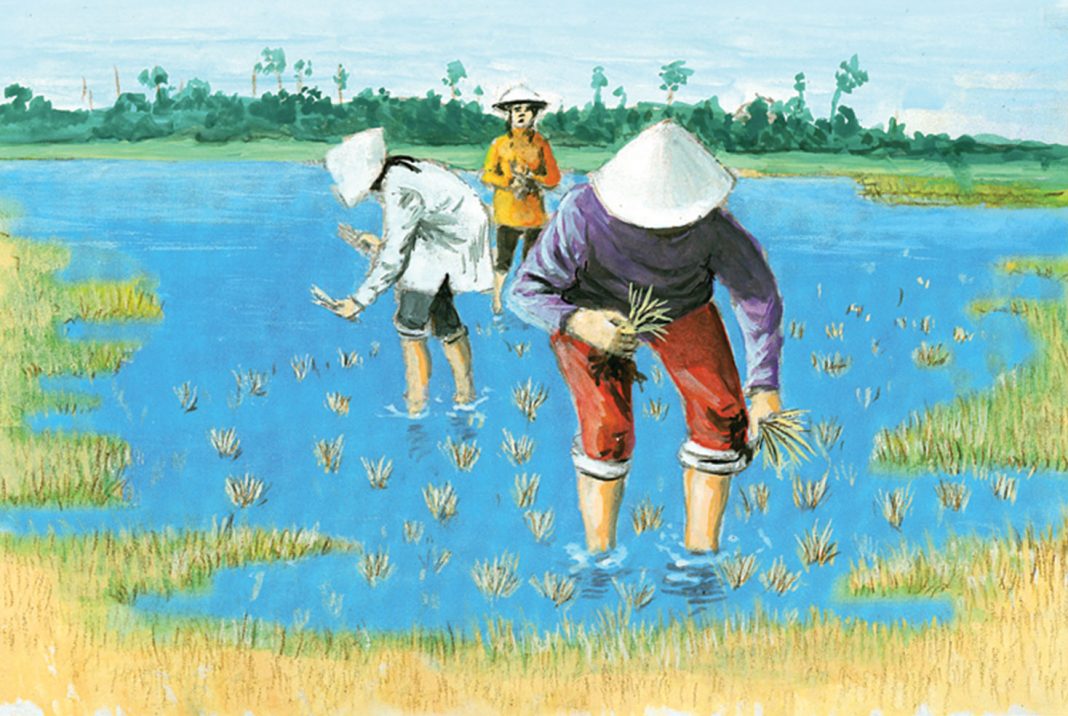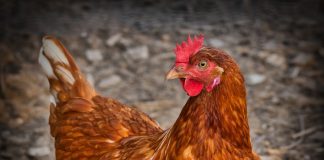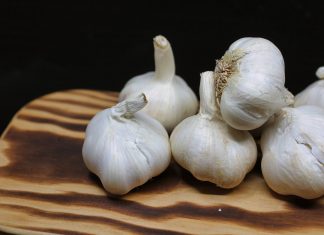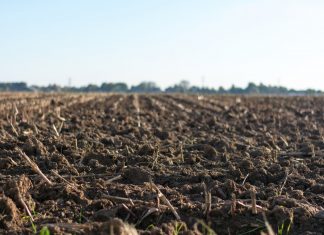|
 |
||
| Issue #115 • January/February, 2009 |
Rice and beans represent two of the most important food families in the human diet.
Rice itself is the principal food for more than half of the world’s population. In places like Cambodia and Bangladesh it provides nearly three quarters of the daily nutritional intake.
Rice is a grain. It’s the fruit of a type of grass and it grows in more than 100 countries, and on every continent except Antarctica. Like other grasses, it will grow in a wide range of environments, including flooded paddies, rivers, or in dry fields watered only by rainfall. Some varieties will grow in relatively hot climates while others in cool mountainous areas.
The wild grassy ancestors of rice evolved more than 100 million years ago on the great continent of Gondwana, which broke up to form South America, Africa, India, and Australia. India drifted northward for several million years and eventually bumped into that great landmass of Asia, raising the Himalayas and the mountain chains that extended east to the South China Sea.
|
Millions of years later, in the warm, wet foothills of those mountains, early humans first gathered wild rice for food. (This is not the rice we call wild rice, today.) It wasn’t long before they realized that these food-producing wild grasses could be sown and selectively bred into varieties that contained characteristics they liked.
Likewise, people in other parts of the world did the same with other species of rice. This early adoption of rice was made possible because of another discovery that was probably more important than farming: Humans had discovered how to control fire and taught themselves to cook.
As folks continued to develop the arts of farming, one of the things they did was select and cultivate whatever rice grew best locally. As rice cultivation began to travel to other parts of the world, people wanted to grow it in environments where it had never before grown naturally. As a testament to its adaptability, when pulled north, south, and west of its natural habitat, rice was able to change and adapt to each new home.
Rice traveled from eastern Asia to southwestern Asia where the Persians learned to grow and harvest it, and created unique ways to prepare it. From there it spread further through the Old World.
The first commercial rice planting in what was to become the United States was made in South Carolina in 1685, where the rice growing knowledge of African slaves was readily available. This planting was made possible after a storm-battered English ship on its way to Madagascar limped into the harbor at Charleston badly in need of repair. The local population supplied labor and materials to repair the ship. In appreciation the ship’s captain gave a local planter a gift of Golden Seed Rice.
The low-lying marshes of the Carolinas and Georgia were ideal for rice production. By the year 1700 the rice crop was so successful that 300 tons of Carolina Golden Rice was exported to England. The quantity shipped would have been greater if the colonists had had more ships to transport it.
After America gained independence, rice became a major agricultural business. In 1849 the gold rush brought people from all over the world to California. An estimated 40,000 Chinese laborers, whose staple food was rice, were included in this group. To feed them and others, farmers in the Sacramento Valley of central California experimented with planting rice. Despite the fact the heavy clay soils were largely unsuited for most crops, the rice plantings were successful.
By 1920 California was a major rice producing state. Today, nearly 90 percent of the rice consumed in this country is produced within its borders.
Today, this country is one of the world’s largest exporters of rice. On a recent trip to a supermarket in my town, I went to the rice aisle to see what was available. To my surprise, the selection of domestic and imported rices was impressive. I found high-quality imported rice from China, Japan, Indonesia, Thailand, India, and Italy as well as domestic varieties of India basmati, Thai Jasmine, Thai red, and Italian Arborio. I even found a brown converted rice under the Uncle Ben’s label that proved to be excellent. This, to me, demonstrates a dramatic increase in the consumption of rice in this country.
The supermarket display I just described occupied more than half an aisle in a large world-class supermarket. Supermarkets don’t provide this kind of space unless a product is a big-time seller. Just a few years ago I would have had to travel to several specialty stores to buy many of the rice varieties I can now find in this one convenient location.
Not all supermarkets have a rice selection like the one I just found, but the selection in most markets is much broader than it has been in past years.
Where populations are dense, such as in much of Asia, rice is usually the first food of choice. In these areas it is usually supplemented with legumes, such as beans or peas, along with small amounts of meat and fish. Recent nutritional studies have shown that this type of diet will provide adequate nutrition at minimal cost.
Unless you develop a passion for exotic varieties of rice, a detailed description of the 100,000 or so distinct varieties is not necessary. Having a basic knowledge of the most common categories of rice readably available in supermarkets today is sufficient.
Processing rice
After rice is harvested it is then thrashed to remove the grain from the straw. This is called paddy rice or rough rice. The outer coating or husk is then removed by machine. This second step gives us brown rice in any of three sizes: long grain, medium grain, or short grain. To get white rice, the grain is milled and polished to remove the bran and germ coating. In many parts of the world, before rice is husked it is parboiled, a process that dates back many centuries and is believed to have been developed in India. This process drives some of the nutrients from the bran into the rice kernel, retaining much of the nutritional value of unpolished rice, and the white rice has more shelf life than unpolished brown rice. This method of parboiling rice wasn’t adopted in this country until the 20th century. And instead of parboiled, the term used here is usually converted. The Uncle Ben’s label produces both white and brown parboiled (converted) or conventional rice.
Sizes
You can easily distinguish the size difference in rice by looking at the grain and taking a visual measurement. The familiar long grain varieties, which include Basmati, Thai Jasmine, and the standard American variety Carolina Gold are slender and elongated, i.e., four to five times longer than wide.
Medium grain rices include risotto (Arborio) and paella (Valencia) and are fat, chalky grains, two to three times longer than they are wide.
Short grain rices are often called sushi rice. They are opaque with grains that are almost round.
Cooking qualities
Rices can also be distinguished by their cooking characteristics. Because of this, you want to choose the right rice for whatever dish you’re trying to create.
|
Long grain varieties contain a high percentage of what’s called amylose starch, which allows them to maintain a fluffy texture with firm distinct grain when cooked. This makes them especially good for pilafs, my favorite method for cooking long grain rice. Amylose starch also causes cooked long grain rice to dry out when cool. I find it necessary to add a small amount of liquid, usually chicken or vegetable broth, to leftover long grain rice when reheating it. All long grain rices should be soaked and then rinsed in cold water before cooking. This removes excess surface starch and allows the cooked grains to remain separate. Also, after soaking and rinsing, the rice should drain for at least 15 minutes to remove excess water.
Medium grain rice is high in amylopectin starch and, as a result, it cooks up tender and a bit sticky. It also resists turning hard and crunchy when cooled. Medium grain rices are preferred when preparing risottos and paellas.
Short grain, or glutinous rices, are low in amylose and high in amylopectin and are the softest and stickiest of the bunch. I find the best method for cooking these rices is to soak them in cold or warm water for a short time, then finish them in a steamer.
Beans and peas
Beans, like rice (and the other foods derived from grasses such as wheat, oats, and barley), rank at the top of the list of important foods in the human diet. Beans are also one of man’s earliest cultivated crops. All varieties of this protein-rich food have origins that go back to prehistoric times.
A remarkable sign of their status in ancient societies is that each of the four legumes known to the Romans lent its name to a prominent Roman family. Fabius comes from the fava bean, Lentulis from the lentil, and both the names Piso and Cicero from the pea. I am not aware of any other food group that has been so honored.
Nearly every part of the world has its own species of legumes, and the cultures that existed in those areas, at one time or another, have been dependent on these plants for their daily nutrition.
Throughout history beans have made the difference between eating and starvation, life and death, in many parts of the world. This is easy to understand, because when beans are thoroughly dried and well stored they are practically indestructible. Along with rice, they can provide critical insurance during times of long-term disaster or other emergency, especially when the availability of fresh food has been limited or is non-existent.
The cultivation of beans has three major advantages to human civilization: as a major source of protein, as feed for cattle and other food animals, and as a means of replenishing nitrogen in the soil.
In the 1600s on the East Coast, Native Americans taught Europeans how to plant corn, beans, and squash together. The corn stalks provided support for the beans as they climbed, and the beans contributed vital nutrients to the soil to benefit both squash and corn. The one distinguishing feature of the bean family is all of the varieties are encased in pods. Beyond that there is a great diversity.
To eat them, some types are dried and later boiled to cook. Others are eaten fresh and immature. Some kinds of beans are ground into flour to make a variety of flat breads. Some are processed into foods that are hardly reminiscent of beans such as soymilk, tofu, and vegetable oil.
Some members of the legume family are used as spices or condiments. Fenugreek is one of them. Others, such as jicama, are often mistaken for vegetables.
We all know that every family has its black sheep and oddballs. The bean family is no exception. Consider Lathyrus latifolius, a perennial better known as sweet pea, which resembles a chickpea but is much smaller. They’re mostly grown in India where they’re called khesari. It’s a tough bean that will thrive in severe drought, and despite its toxic effect when eaten in large amounts, it is often consumed by the very poor in times of famine. Several years ago I found this bean in a small Italian grocery store in New York City. The owner, sounding like a botanist, cautioned me about the possible toxic effects of this bean. However, he also assured me that toxic effects could only be experienced when the bean is eaten in large quantities.
This was of little comfort to me since I had recently come across an article on the famine that was rampant in Ethiopia in 2000, where an epidemic of lathyrism, a severe disease of the nervous system was linked to the consumption of this bean. I only mention this peculiar bean as a small aberration in a very large family of edible and nutritious plants because, as unlikely as it may be, it is possible that these beans may be available elsewhere, and sold to an uninformed customer. This little store was located in an ethically diverse neighborhood and was frequented by folks who were very knowledgeable about foods like this and the owner was good at recognizing innocents such as myself.
On the bright side, today there is a nontoxic variety of sweet pea that is used as cattle feed and is a beautiful flowering perennial. Its seeds can be purchased at well-stocked nurseries or on the web.
Poor man’s meat
In years past, and in many parts of the world, beans have been labeled as “poor man’s meat.” More than any other food, beans have been associated with poverty.
In most societies, where people can obtain protein from animals, beans are often reviled as food for the poor. However, as the cost of breeding and raising animals for food rises, as it has been for the last several years, beans and grain products such as rice are becoming more popular. With the cost of living constantly spiraling upward, beans, rice, and vegetables are indeed being recognized as a cheap, economical, and satisfying way to meeting nutritional requirements.
In places like China, India, and other countries with high population densities, beans and rice retain a central role in the diet to this day. I have worked in the food industry for nearly 40 years, during which time I have worked with some very talented men and women from all over the world. They came from countries that practiced very different culinary traditions from ours, and without exception, each of them had a favorite dish that was emblematic of their countries’ national identity. These ethnic favorites often included rice and beans as basic ingredients.
In the recipe section I include some of my personal favorites. Oh, yes! These recipes have also passed muster with my ever-tough recipe review committee: Sarah, Jason, and Michael, my three children. Only one of the recipes in the next section contains meat. This is not an oversight. In any disaster situation I feel that meats will be the most difficult to store and prepare.
Also, some of the recipes call for low sodium chicken or vegetable broth. I have experimented with canned broths produced by several manufacturers, and find the reduced-sodium broths made by Swanson are high quality with excellent flavor. As I mentioned above, white rice, parboiled riceboth white and brown, dried beans and peas are almost indestructible when stored in a cool environment and kept dry. These two foods, when combined with a variety of vegetables, both dehydrated and fresh, will provide adequate nutrition for you and your family for as long as necessary.
|
There are a number of basic techniques for getting the best flavor and consistency from your bean recipes that I offered in a previous article on this subject (Beansthey may be a poor man’s meat, but they are also the gourmet’s delight, available in A Backwoods Home Anthology: The Seventh Year). Beans are a frequent menu item in our house, especially since my son Michael decided to adopt a vegetarian diet. In that previous article I cautioned that adding salt to beans before they are fully cooked will prevent them from cooking completely. In recent years I have found this to be only partially true. My longtime standard method for cooking beans is to limit soaking to four hours or skip it entirely, depending on how much time I have to prepare my selected dish. The main difference is cooking time. Beans that are not soaked require extended cooking.
However, in some recipes I have discovered that soaking beans in a light brine solution eliminates a problem that I often encountered when baking various bean casserolesi.e., tough skins. Brining beans before cooking is not the same as adding salt while they’re cooking. Cooking beans in salted water will give the cooked beans a mealy texture. The presence of salt in the cooking water limits the amount of water the beans can absorb, preventing some of the starch granules from softening completely.
Brining, followed by careful rinsing of the beans in cold water, simply creates an ion exchange limited to the skin of the bean. Sodium ions in the brine replace some of the calcium and magnesium ions in bean skins. Sodium ions are weaker than other mineral ions allowing more water to penetrate the skins, hence, softer skins.
Bean varieties at a glance
The bean family is huge and covers a lot of ground, as they come in many varieties and are grown all around the globe. In this country we are most familiar with the Phaseolus or “common bean” branch of the family. The most prominent members of this group include cannellini, kidney, navy, pinto, Roman, pink, black beans, as well as many others. Each of these beans has several subvarieties. For instance, the Black Turtle, Swedish Brown, ancient Anasazi, Great Northern, and the White Kidney bean are all varieties of the common kidney bean, and there are dozens more. There are also three other varieties of Phaseolus, which include the lima bean (Phaseolus lunatus), the Tepary bean (Phaseolus acutifolius), and the Runner bean (Phaseolus coccineus).
Another genus (Vigna) includes the azuki, Fava, moth bean, mung bean, black-eyed pea, and the cow pea. There are at least 10 other genera that include familiar beans like chickpea, soybean, lentil, and others. To discover which bean is to your liking you will have to experiment. A good place to start your journey of discovery is your local grocery store. All of the beans I use in the recipe section came from the supermarket in my neighborhood.
If you, by some chance, exhaust all of the supermarket varieties and still have a desire to continue your search, a good place to continue is Bob’s Red Mill (www.bobsredmill.com). This company has a great website which is easy to navigate, and the service is great. Don’t feel bad if you have trouble determining which bean you like best. I have been trying to decide for about 25 years. What I’ve discovered during this time is that legumes are delicious, healthful food with limitless recipe possibilities. The same can be said for the many varieties of rice.
The recipes that follow are not written in stone. Each of them has dozens and probably hundreds of variables. Please don’t wait for an emergency or disaster situation to start assembling a bean-and-rice recipe collection. You will be missing out on a lot of delicious, healthful, and satisfying meals if you do.
Cooking tips for rice
Professional cooks use one of four basic methods for cooking rice, depending on the type of rice and how it will it be served or used in a recipe. All recipes that include rice as an ingredient must have a production method that will ensure the rice is cooked properly when the dish is ready for the table. Cooking time and volume must be adjusted to complement the type of rice selected for the recipe.
Our family eats rice several times a week, in recipes and as a side dish. Before my daughter, Sarah, and my son, Jason, went off to college, they bugged me for weeks to give them instructions on how to cook rice. Sarah was the most insistent.
“Dad, if I can’t cook rice and pasta the way we do at home, I might waste away.”
Her college minor is theater arts, and if you could witness this performance you would understand why. But she’s good at it and the following suggested recipes and cooking instructions are taken from notes I sent with my children as they left for school. They’re both still alive and well, so I feel that this is worth sharing with everyone else.
The four standard methods for cooking rice are:
- the absorption method
- the pilaf method
- the oven method
- the lots-of-water method, also known as the pasta method
As mentioned earlier, all long grain white rices should first be soaked for 15 to 30 minutes and rinsed before cooking. This removes excess surface starch and improves the cooking properties of these rices. Since non-converted brown rice still has a bran layer covering each grain, this step is not necessary.
The absorption method: This method will produce excellent results with all rice sizes: long grain, medium grain, and short grain. Simply combine the rice, liquid, and salt in a heavy-bottomed saucepan. Bring the mixture to a boil over medium-high heat. Gently stir the rice at the first signs of boil, and then put the spoon awayi.e., don’t keep poking at the rice. Cover the pot, reduce the heat to low, and simmer until grains are tender. Resist the temptation to lift the lid and peek while the rice is cooking. When the suggested cooking time has been reached, remove the pot from the heat, let it reststill coveredfor at least 15 minutes before serving.
The pilaf method: This is best used only with long and medium grain rice. However, I found the short grain varieties cooked well using this method to make risotto and paella.
This method calls for first cooking the rice in butter or oil before adding the liquid, which adds a mellow, nutty flavor to the finished rice. When cooking rice using this method I first sauté one clove of minced garlic and one half of a chopped small yellow onion, about one quarter cup, in one tablespoon of olive oil before adding the rice.
Heat one tablespoon of olive oil or butter for each cup of rice in a heavy-bottomed saucepot over medium-high heat. Add the rice and cook, stirring constantly, until it becomes chalky and opaque. Add the liquid along with ½ teaspoon of salt for each cup of rice. Bring the mixture to a boil, stir briefly with a spoon, then put the spoon away. Reduce the heat to low, cover, and simmer until the rice is tender. Fluff with a fork and serve.
The oven method: This, in my not-so-humble opinion is the best method for cooking brown rice or large quantities of any rice.
|
Heat the oven to 375° F with a rack in the middle position. On top of the stove, bring the liquid in a covered heavy-bottomed saucepan to a boil. Combine the rice, salt, and boiling liquid in a baking dish or casserole. Cover the dish or casserole with a tight-fitting lid or a double layer of aluminum foil. Bake until all grains are tender. After removing the rice from the oven, let it rest for five minutes, covered. Uncover, fluff the rice with a fork, and serve.
Lots-of-water method: This method works best with firm long grain varieties of rice, like rices that have been processed by parboiling. I use this method when using parboiled (converted) rice in cold salads. It produces a rice with a soft texture, without being mushy.
Bring four quarts of water to a boil, for each cup of rice, and add one tablespoon of salt. Simmer until the grains are tender, then strain the rice in the sink through a fine-meshed strainer. If you’re serving the rice at a current meal, let it stand in the strainer for five minutes. If the rice is intended for later use, spread it on a cookie sheet lined with parchment paper or aluminum foil to cool. Once cool, transfer the rice to a plastic or glass storage container with a tight-fitting lid and refrigerate.
Basic formulas
White rice, absorption method:
Ingredients:
|
Cooking time 12 to 15 minutes
Rest time 12 minutes
Yield 3 cups
Brown rice, oven method:
Ingredients:
|
Cooking time 60 minutes
Rest time 5 minutes
Yield 2½ to 3 cups
Basic recipe for stewed beans. When prepared properly, plain stewed beans can be stored in the refrigerator for three days or frozen for two weeks. I like to keep some stewed beans in the refrigerator for a quick snack or for adding to a recipe that I feel needs a little enhancement. One of my favorite snacks is heating some leftover rice with some stewed beans and dressing them with a little grated cheese and hot sauce.
Ingredients:
|
Method:
1. To retain maximum flavor in the cooked beans I do not soak them when I cook them using this formula. Rinse them in cold water and let them drain in a strainer for at least 15 minutes.
2. Put the beans in a suitably sized heavy-bottomed pot over medium-high heat and bring to a boil.
3. Add the onion, carrot, and garlic.
4. Reduce the heat so the beans are cooking at a slow simmer and cover. Since the heat will increase with the cover in place, it will be necessary to check the cooking rate after a few minutes. Reduce the heat, if necessary, to maintain a slow simmer. Cook the beans for 1½ to 2 hours or until they are tender without being mushy.
5. You can also put the beans in a preheated oven set at 300° F. Depending on the bean variety and how long they have been in storage, cooking time may be longer. After the first two hours, check the beans every 15 to 20 minutes or until tender.
Rice and lentil casserole. Lentils are native to the Fertile Crescent of southwestern Asia, the birthplace of Western civilization, and what is today eastern Turkey, northern Iraq, and Syria. This bean has been domesticated for at least 10,000 years and, over the years, has weathered the harshest of growing conditions.
Basmati rice is a fragrant long grain rice that has been used in India and Pakistan for thousands of years. There are several hybrids available under trade names like Texmati and Kasmati. These are basically good rices, but they do not have the full flavor of the original. In this recipe I have paired these ancient foods in a simple formula with two dried fruits and caramelized onions. This casserole is great served by itself, with a side salad, or as a side dish.
Ingredients:
|
Garnish ingredients:
|
Method:
1. Preheat the oven to 350° F.
2. Dissolve one teaspoon of salt in the five cups of water and add the rice. Let the rice soak for at least four hours or up to eight hours. Drain and rinse the soaked rice and place it in a colander and let drain again for at least 15 minutes.
3. In a large pot bring the 10 cups of water to a boil and stir in the one tablespoon of sea salt. Add the rice and cook it at a rolling boil for at least four minutes. Drain the rice and rinse under cold running water.
4. Cook the lentils in a small saucepot with just enough water to cover them for about six minutes. In the last minute of cooking add ½ teaspoon of sea salt. Drain.
5. Lightly fry the dates in one teaspoon of olive oil.
6. Coat the bottom of a medium casserole dish with one tablespoon of olive oil.
7. Spread one-third of the rice over the bottom of the casserole and spread the lentils over the rice. Spread another third of the rice over the lentils, then spread the dried cranberries over this second layer of rice. Spread the last third of the rice atop the cranberries. Spread the dates evenly over this last layer of rice. Drizzle the melted butter over everything. Cover the casserole tightly with a piece of aluminum foil and fit the casserole lid over the foil.
8. Place the casserole in the oven and cook for 45 minutes.
9. While the rice is cooking, heat the remaining olive oil in an 8 or 10 inch heavy-bottomed pan over medium heat until it ripples. Add the sliced onion and cook, stirring frequently until the onion is medium-brown. Transfer it to a warm dish, cover, and set it aside.
10. Take the casserole from the oven, remove the lid and the foil, spread the onions evenly over the casserole and serve immediately.
Tuscan bean stew. The people of Tuscany proudly refer to themselves as mangiafagioli, or “bean eaters,” for the prominent role beans play in their cuisine. This stew is one of the classic recipes in Tuscan cuisine.
To add my own signature to this classic dish, I have added a small amount of smoked sausage and an additional root vegetable to the original formula. However, I have also made this stew without meat to make it vegetarian for my son, Michael. Both versions are packed with flavor and make for a nutritional stand-alone meal. A side of basic white or brown rice, or a green salad with a vinaigrette dressing, will also complement this stew. Like most of the recipes in this section, this stew reheats well.
Ingredients:
|
Chili and garlic oil for the bread.
Ingredients:
|
Method:
1. Combine the salt and water in a large container and add the beans. Soak the beans for at least 8 hours. Drain the beans and rinse thoroughly in cold water.
2. Preheat the oven to 250° F.
|
3. Heat the oil in a large Dutch oven until it begins to ripple. Add the sausage and cook until the sausage begins to brown. Add the onions, celery, carrot, and parsnip. Cook the vegetables, stirring occasionally, until they are softened and lightly browned. Add the garlic and cook until it becomes fragrant.
4. Stir in the broth, water, beans, and bay leaves. Bring the mixture to a simmer. Cover the pot and place it in the oven and cook until the beans are almost tender, (the center of the beans will still be firm) about 35 to 45 minutes.
5. Remove the pot from the oven and carefully stir in the kale, cabbage, and tomatoes. Return the pot to the oven, covered, and cook until the beans and greens are completely tender.
6. During the final 15 minutes, place the rosemary in the pot.
7. Remove the bay leaves and the rosemary prior to service. Season with salt and fresh ground black pepper, to taste.
8. Prior to serving, brush both sides of the bread with the prepared garlic oil and toast under the broiler until both sides are browned. Place a slice of toasted bread in each serving bowl and ladle the stew over the bread. Come to the table hungry and enjoy a great meal.
Baked spiced black-eyed peas. I have made the recipe with both black-eyed peas and cow peas, a close relative to the black-eyed pea. My son, Jason, loves black-eyed peas prepared in any fashion. To keep him happy I am constantly looking for new recipes. Next to his favorite “Hoppin’ John” (“Southern cooking that doesn’t just whistle Dixie,” A Backwoods Home Anthology: The Seventh Year), this recipe ranks in the number two slot.
For a while, one of my favorite culinary antics to create interesting conversation at the dinner table, was to serve this recipe with a side of steamed Chinese long beans. At some point during the meal I’d ask if anyone knew the relationship shared by these two beans, and wait for the puzzled looks on the attending faces. Then, one day, my daughter Sarah looked at me with a familiar smirk on her face. “Daddy,” she said, “everyone knows that they are the same bean. Long beans are simply fresh black-eyed peas.” I’m still looking for a new culinary tidbit for my dinner table.
Ingredients:
|
Marsala paste ingredients:
|
Final preparation ingredients:
|
Method:
1. Preheat the oven to 250° F.
2. Combine the salt in the water in a large container and add the beans. Soak the beans for at least four hours, then drain and carefully rinse.
3. Place all Marsala paste ingredients in a food processor, blender, or mortar, and grind to a paste.
|
4. Heat the oil in a Dutch oven until it begins to ripple. Add the cumin and mustard seed and stir briefly. Add the Marsala paste and sauté over medium heat, stirring frequently for two to three minutes. Add the bay leaves, turmeric, and coriander and stir. Add the yogurt, one tablespoon at a time, stirring thoroughly after each addition.
5. Add the beans and the broth and bring the mixture to a boil. Immediately remove the pot from the heat and place the pot in the oven. Bake uncovered for 45 minutes, then put the cover in place. Continue cooking until the beans are tender. Remove the pot from the oven and allow the beans to rest, covered, for 15 minutes before serving.
You can thicken the sauce, if desired, by mashing some of the beans against the side of the pot with a spoon and mixing them in. Serve on a plain rice of your choice.
Vegetable risotto. There is little I can say about this dish except that it’s one of the classic rice dishes, and a must inclusion in any recipe collection. It is also one of the most versatile. The number of variations is almost endless. It is a great platform for highlighting the hearty flavors of root vegetables and winter squashes. In this formula I have included butternut squash since it is plentiful and cheap this time of year. In the spring, young asparagus is a great replacement for the squash.
Ingredients:
|
Method:
1. Before you start cooking, I suggest you slice and measure all of the vegetables, measure the rice, wine, and combine the broth and water in a suitable size container. Completing the prep work ahead of time will allow you to pay attention to the consistency of the rice as it cooks. Adding the wine and broth at the proper time will prevent scorching or burning of the rice.
2. Prepare and combine the lemon zest and parsley. Place it in a small dish and set it aside.
3. In a suitable size saucepot add the combined water and stock and heat to just below the boiling point. Reduce the heat, cover the pot, and keep it warm until you are ready to incorporate it into the recipe.
4. Heat one tablespoon of olive oil in a Dutch oven over medium-high heat until it begins to ripple. Add the carrot and cook gently, stirring for about two minutes, and then add the squash and the green beans. Continue cooking the vegetables until they a crisp-tender. Remove them from the pot and set them aside.
5. Add two tablespoons of olive oil to the now empty pot over medium heat and add the onions and salt. Sauté the onions, stirring frequently until they soften and turn translucent.
6. Add the rice and stir until the grains turn translucent around the edges.
7. Add the wine and cook stirring frequently until the wine is completely absorbed.
8. When the wine is absorbed add three cups of hot broth to the rice. Simmer, stirring every couple of minutes until the broth is completely absorbed and the bottom of the pot is dry. This will take about 10 minutes
9. Stir in another half cup of broth and stir frequently until it is completely absorbed. Repeat this step three or four times until the rice is al dente.
10. Gently fold in the cooked vegetables and remove the rice from the heat.
11. Gently stir in the melted butter, Romano cheese, lemon juice, and black pepper into the rice. Sprinkle the rice with the parsley-zest mixture and serve immediately.
Brown rice and vegetable pilaf. Converted or parboiled rice is available in two forms, with or without the bran layer. I first prepared this recipe with Uncle Ben’s brown rice because I didn’t have enough of the rice that was my first choice, brown basmati. After searching my cabinets and storage area I found instead this rice my wife, Tricia, bought a few weeks earlier. I decided to give it a try and hope for the best. Whatever reservations I had about using the commercial standard disappeared as soon as the rice came out of the oven. I now have a five-pound bag of this rice in storage and plan to use it on a regular basis. This is another example of the amazing versatility of this wonderful food.
Ingredients:
|
Garnish ingredients:
|
Method:
1. In a suitable size container combine the rice and cold water. Set the bowl aside and let the rice soak for one hour. After soaking, rinse the rice, place it in a strainer and let it drain for at least 15 minutes. While the rice is soaking preheat the oven to 350° F.
2. Heat the olive oil in a Dutch oven over medium-high heat, add the carrots and onion and cook, stirring frequently, until the vegetables start to brown.
4. Add the rice and cook the mixture, stirring frequently, until the rice turns translucent.
5. Add the garlic and ginger and cook for 30 minutes or until the rice becomes fragrant.
6. Add the garam marsala, cumin seed, whole cloves, bay leaf, and turmeric. Cook this spice mixture for another 30 seconds. Add the salt, cayenne pepper, and low-sodium vegetable broth. Raise the heat and bring the mixture to a boil. Immediately remove the pot from the heat, cover and place the pot in the oven. Bake for 35 to 40 minutes. Check the rice before removing the pot from the oven. The rice should be tender but not mushy. If the rice isn’t yet tender, leave it in the oven but check again every five minutes. You don’t want to overcook it.
7. After removing the rice from the oven, gently fold in the peas, and evenly distribute the chopped cilantro on top. Serve immediately. This pilaf goes well with the baked black-eyed peas or any variety of stewed beans.
Vegetarian chili. After my success using a commercial brand of rice in the previous recipe, I decided to give some of the canned beans a try. Canned beans are easy to use, inexpensive, and readily available in all supermarkets. My main concern was whether they hold up when cooked for long periods. Experience has taught me that chili, of any kind, must stay over the heat for at least two hours. Once again, my doubts were proven unfounded. I cooked this on the stove top for two hours and in my slow cooker for four hours at the high setting. Both methods produced great chili.
Ingredients:
|
Method:
1. Chop the tomatoes, with their juice, in a food processor until they are slightly chunky. Combine them with the salsa and set the mixture aside.
2. Heat the olive oil in a 12-inch skillet over medium-high heat until shimmering. Add the onion, garlic, chili powder, cumin, and ¼ teaspoon salt. Cook this mixture until the onions are soft, 10 to 15 minutes.
3. Turn off the heat and stir in the tomato-salsa mixture, low-sodium broth or beer, and chipotle pepper. Transfer this mixture to the slow cooker insert and stir in the beans, sugar, and honey until well blended.
4. Cover and cook on high for four to five hours. (You can instead transfer the mixture to a suitable size Dutch oven and bake at 250° F for 1½ to 2 hours.
5. Unplug the slow cooker and remove the insert or remove the chili from the oven. Stir in the vegetables and cilantro and add salt and pepper to taste. Cover the chili and let it sit until the vegetables are heated.
6. Serve over plain white or brown rice.
Dragon fire cabbage. For me, the greatest disaster of all is suffering from jaded taste buds. When this happens, I wing up a recipe like the one that follows. A few months ago my sons Jason and Michael asked me to prepare a different vegetable that wasn’t boring. This is what I made for dinner that night. If you ever feel the need for a different vegetable, give this a try. It pairs well with a bowl of plain rice. Be warned though, it bites a little.
Ingredients:
|
Method:
1. Cut the cabbage and set it aside.
2. In a small bowl combine the garlic chili sauce, salt, brown sugar, sesame oil, soy sauce, and dry sherry. Set this mixture aside near the stovetop.
3. Heat the peanut oil in a 12-inch skillet over high heat until it is shimmering. Add the cabbage and cook it stirring constantly for one minute.
4. Add the seasoning mixture and continue cooking until the cabbage starts to wilt, but is still slightly crispy.
5. Sprinkle in the rice vinegar and stir again. Adjust seasoning with fresh ground black pepper to taste. Serve this over plain white rice or over basic stewed beans of your choice.
|
|
|
|
|
|
|
|






















I made the rice and lentil casserole this weekend and it left the (brown) basmati totally crunchy. I recommend adding liquid to create some steam to actually cook the rice.